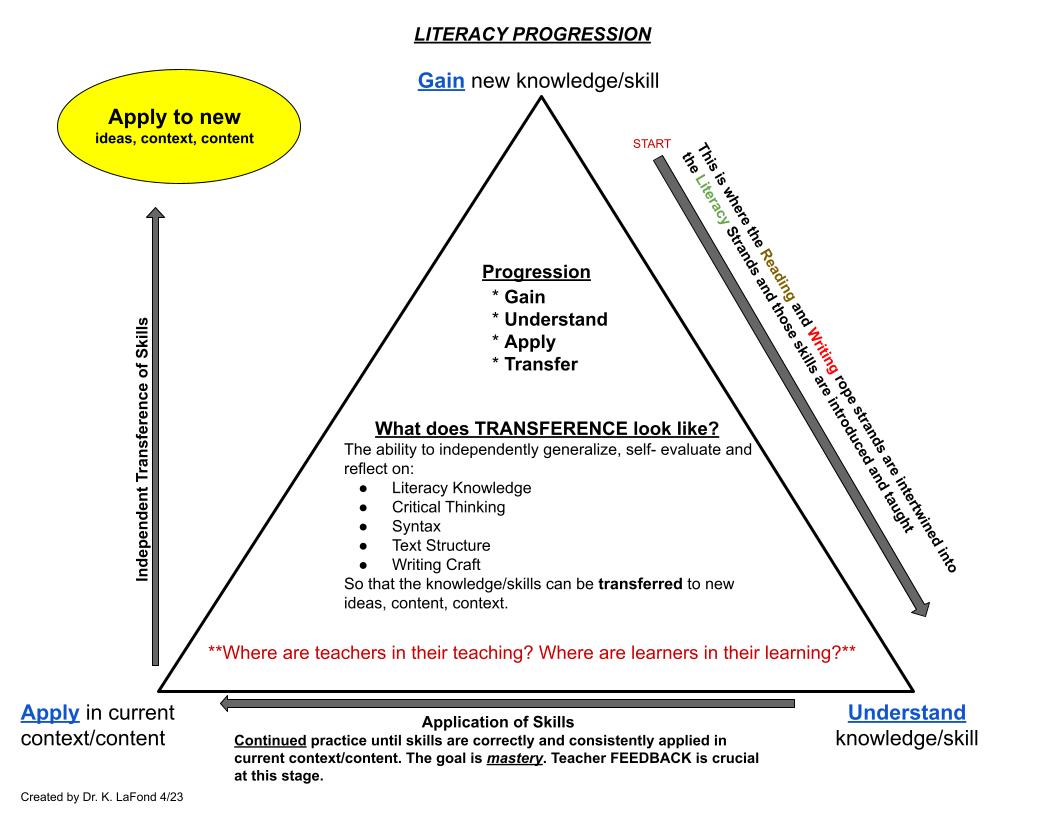You are here
The Literacy Progression: Knowledge, Understanding, Application and Transference of Reading and Writing Skills
“Read not to contradict and confute; nor to believe and take for granted; nor to find talk and discourse; but to weigh and consider. Some books are to be tasted, others to be swallowed, and some few to be chewed and digested…” --Francis Bacon
"If you cannot write well, you cannot think well, and if you cannot think well, others will do your thinking for you." --George Orwell
A strong command of the language arts (reading, writing, speaking, and listening) is vital for being a successful student and ultimately a productive member of the 21st century workforce. Language skills have always been fundamental for academic and professional success. However, students in the 21st century are now facing more complex challenges in an ever-changing global society. These challenges have not only created the need examine and discuss the intersection, interdependence, and interconnection that exist between each literacy (reading, writing, and communicating, but also how each level of Colorado's education system (the state, our districts, and schools) approach to language arts to ensure each Colorado student can demonstrate literacy and language proficiency as outline in the Colorado Academic Standards for Reading, Writing, and Communicating.
Literacy Study is Essential to Academic Success in All Disciplines
Literacy – meaning the ability to construe a written, linguistic, alphabetic symbol system – is arguably the most important skill students acquire in preschool through twelfth-grade education because it makes all other forms of higher-order learning, critical thinking, and communication possible.
The study of reading, writing, and communicating is therefore essential to all other study in early childhood education, primary school, and secondary school. Such study comprises not only the fundamental knowledge and skills of literacy and the language arts (reading, writing, speaking, and listening), but also the knowledge and skills of discourse (dialogue and discussion) and rhetoric (the ability to make arguments and to think critically about arguments made by others) and the knowledge and skills involved in responding to imaginative literature and informational texts.
Literacy Progression: Where Scarborough's Rope and Sedita's Writing Rope Intersect
Literacy skills are essential for students to fully participate in and expand their understanding of today’s global society. Whether they are reading functional texts (voting ballots, a train schedule, a driver’s test, a job application, a text message, or product labels); reference materials (textbooks, technical manuals, electronic media); or print and non-print literary texts, students need reading skills to fully manage, evaluate, and use the myriad information available in their day-to-day lives. Similar to reading, writing is a fundamental component of literacy. Writing is a means of critical inquiry; it promotes problem solving and mastering new concepts. Adept writers can work through various ideas while producing informational, persuasive, and narrative or literary texts. In other words, writing can be used as a medium for reasoning and making intellectual connections. As students arrange ideas to persuade, describe, and inform, they engage in logical critique, and they are likely to gain new insights and a deeper understanding of concepts and content.
Oral language foundation and written symbol systems concretize the way a student communicates. Thus, students in Colorado develop oral language skills in listening and speaking, and master the written language skills of reading and writing. Specifically, holding Colorado students accountable for language mastery from the perspectives of scientific research in linguistics, cognitive psychology, human information processing, brain-behavior relationships, and socio-cultural perspectives on language development will allow students to master 21st century skills and serve our communities, state, region, and nation well.
The Approach: Ensuring Literacy and Language Proficiency

In Colorado, we measure literacy and language proficiency or mastery based upon a student's knowledge, understanding, and demonstration of grade-level standards. While the Colorado Academic Standards are a reflection of the floor and not the ceiling of what students should know, understand, and be able to do, statewide data, analysis, and feedback from district and school leaders, classroom teachers, and students reveal a missing element—the transference of knowledge to new ideas, contexts, and content. Transference is the students' and teachers' ability to generalize, self-evaluate, and reflect on literacy knowledge, critical thinking, syntax, text structure, and writing craft. The goal is for students to be able to transfer their acquired knowledge/skills to new ideas, concepts, and contexts.
Building and expanding upon how the literacy and language skills in Scarborough's Reading Rope and Sedita's Writing Rope intertwine in order to demonstrate how students gain, understand, apply, and transfer knowledge and skills, the Colorado Framework for Writing Instruction Committee, created the graphic below to help district cohorts/teams develop their own framework for writing and writing instruction from the lens and essence of the Colorado Academic Standards for Reading, Writing, and Communicating.
Back to the Main Page
Previous page: Ground the Work: The "What" and "Why" of Writing
Next page: Process for Developing a Writing Framework


Connect With Us





